Its Dark Fish Eye Lense Youre the Baby Quote
Fisheye lens photography is a genre that depends completely on one affair: the farthermost panoramic perspective created by the fisheye lens.
These lenses are wild beasts in the world of photographic camera lenses, due to their huge field of view and strong visual distortions.
Some people love them, some hate them. Some consider them to exist toy lenses, with no real use other than creating funny and weird-looking portraits. And others see them as a way to make a argument through a distorted merely eye-communicable image.

In reality, fisheye lenses are much more than curiosities. They are a very particular tool that can produce powerful effects in the hands of a skilled lensman.
This article is all about how to master your fisheye lens so that you can create stiff and original images that will stand out from the crowd with their unique characteristics.


What Is A Fisheye Lens?

A fisheye lens is a type of lens that produces an extreme broad-angle image with distortions that make direct lines appear curved.
Equally its proper noun indicates, it is based on how a fish would meet things beneath the surface of the h2o, with an ultra-wide hemispherical view of everything in front end of it. By 'ultra-wide hemispherical view', I mean precisely that the lens has a 180° field of view (which is one-half of the 360° of a sphere, hence the term hemispherical).
The term 'fisheye'wasoutset usedto depict these kinds of photographic lenses in 1906 by Robert W. Woods, an American physicist and inventor.
While fisheye lenses will always projection a round paradigm on the camera sensor, they can be grouped into two families: round and total-frame fisheye.
A round fisheye lens will projection the whole hemispherical image onto the camera sensor. A full-frame fisheye lens, nevertheless, will project an image larger than the camera sensor. This leads to a non-circular photo with a field of view smaller than 180°. The photo below shows a comparison between images produced by the 2 kinds of lenses.
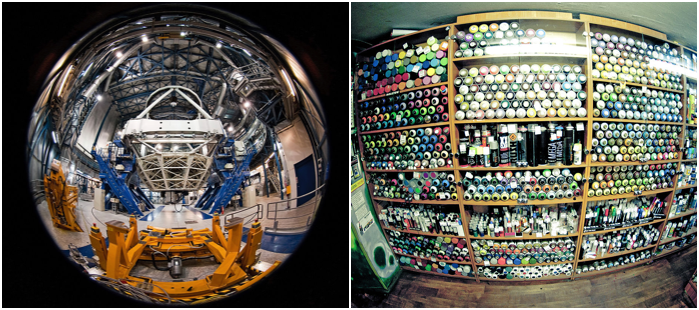
Some Fisheye Lens Recommendations
Due to their huge field of view, fisheye lenses are unremarkably found in action cams (e.g. GoPro cameras). Relatively inexpensive fisheye lenses are also available for iPhone and other camera phones (e.g. the Olloclip 4-in-1 set). And all the major camera lens manufacturers, such equally Canon, Nikon, Olympus, Sigma, Sony, Samyang, etc., have a fisheye lens available in their itemize.
Finally, fisheye lenses come in all sorts of prices. From the $950, pro-grade Olympus M.Zuiko Digital ED 8mm f/i.8 Fisheye PRO lens all the way down to the much cheaper, but fully manual, Samyang / Rokinon / Bower fisheye lenses.
I ain the fully manual Samyang 7.5mm f/3.5 UMC Fisheye lens for my Olympus micro 4/3 camera and it is a joy to use. If you lot are tempted to become a fisheye merely don't want to spend too much on it, practise not be afraid to get fully manual. Thanks to the very large depth of field, transmission focusing is actually quite a hurting-free process.
[Note: ExpertPhotography is supported by readers. Product links on ExpertPhotography are referral links. If yous apply one of these and buy something, we make a little bit of money. Need more than info? Encounter how it all works here. — Ed.]
Fisheye Lenses and Optical Distortions
Fisheye lenses, together with rectilinear wide-angle lenses, have a focal length less or equal to 24mm (equivalent to full-frame sensor size). This means they fall into the ultra wide-angle lens category.
Rectilinear broad-angle lenses are built in such a way that straight lines in the scene will be rendered straight (uncurved) in about parts of the image, with increasing amounts of distortion towards the edges of the frame.
In general, the shorter the focal length, the more than difficult it is to rectify the lens. Fisheye lenses e'er manifest a potent curvilinear butt distortion, as shown in the prototype below.
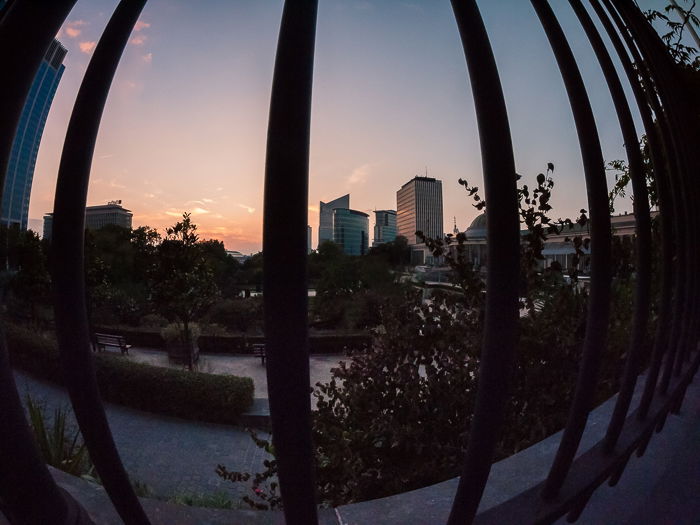
Many people do not like the fisheye effect because they practise not like the resulting distortion in the images. In some cases, you tin can employ post-procedure methods, such as defishing techniques using Lightroom or more specific software (e.g. IMADIO Fisheye-Hemi), to lessen the amount of baloney, or remove it birthday.
In full general, though, conscientious composition and selection of subject can greatly reduce the visual touch of the fisheye distortion without the need for extra editing, particularly with total-frame fisheye.
So, how does a fisheye lens work in practice? All you need to think to beginning doing serious fisheye photography is:
- The central office of the frame is less affected by the distortions
- The more you close in on your subject, the larger the distortion in the resulting image will be
- If you want a flat horizon, identify it in the eye of your frame, and crop the photo afterward to satisfy composition rules, such equally the rule of thirds
- Tilt the lens upward to achieve a concave horizon
- Tilt the lens downward for a convex horizon
What Are Fisheye Lenses Good For?
In general, fisheye lenses are dandy travelling lenses for your camera. Because they are more often than not fast and you can easily use them indoors, they are great for taking photographs in museums, churches, and monuments.
They are equally practiced lenses for walking around the city. Fisheye lenses allow yous to emphasise the summit of buildings and monuments, likewise as capture wide birds-center views looking down at the city from high vantage points.
If you like the natural mural, fisheye lenses are perfect for capturing wide panoramic views and as well to photograph nocturnal landscapes and the Milky Manner in all its glory.
Ane matter's for certain—because they are quite unlike from any other kind of lens, if you lot are stuck in a photographic heat, fisheye photography is a bang-up mode to get your artistic spark back.
Allow'southward accept a look at a few subjects you tin can photograph with a fisheye lens, and how to get some stiff effects.
Fun and Weird Images
The most straightforward style you can use a fisheye lens is to create funny and weird-looking images. Attempt to use the fisheye distortions when photographing a pet's nose from up close, as with the domestic dog in the prototype below. Big nose and begging eyes, teeny tiny body, great fun.
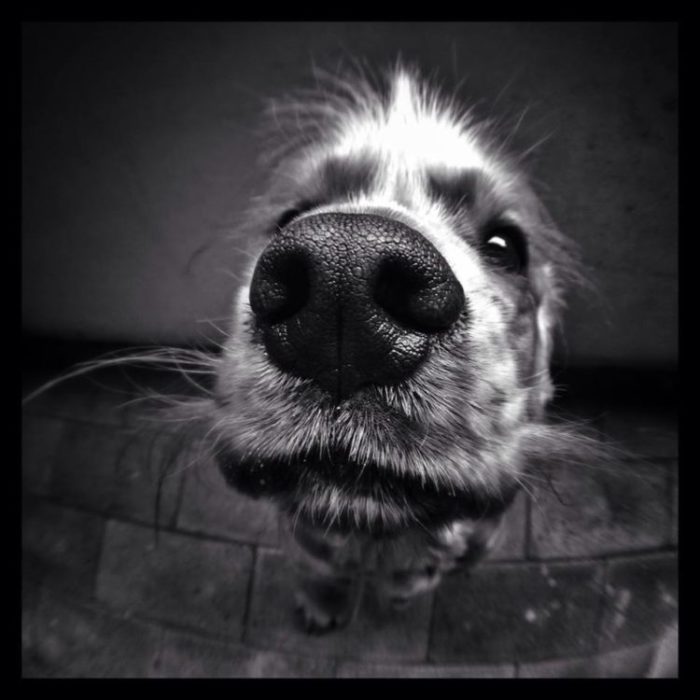
You can also tilt the camera upward or downwardly and rotate it to create funny landscapes from your otherwise unremarkable city park.
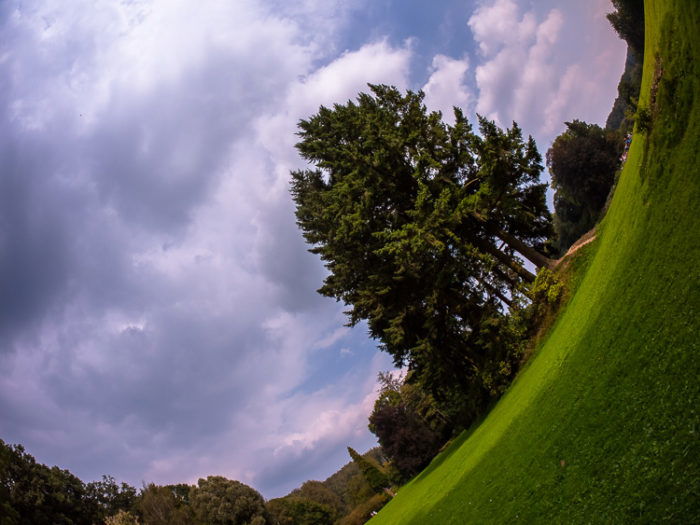
Finally, y'all can accept advantage of the huge field of view and place your camera in small, secluded spots.
What about a selfie from deep inside your washing auto?
Simply brand sure the place is dry out and remove your camera before washing your wearing apparel. Note how, in the photo beneath, I managed to place myself towards the centre of the frame, thus fugitive strong distortions on my face.
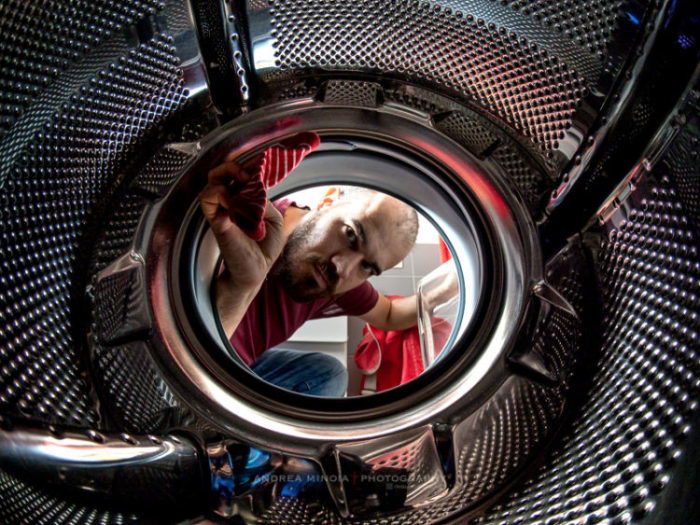
Portraits
Ordinarily people will not exist flattered by having you lot taking their portrait with a fisheye lens—the nose will be also big, while the ears and body will be too modest. In curt, yous will mess up the typical proportions of the face, particularly if you get for a headshot or for close-ups.
But, in toddlers and very immature children, confront proportions are still quite unlike from those of the average adult. Kids of this age have pocket-size noses and huge, beautiful eyes in contrast to the rest of their faces.
With a fisheye lens you can raise these youthful proportions past making the toddlers' eyes even larger, particularly if shot in close quarters, like from just beneath a machine seat canopy.
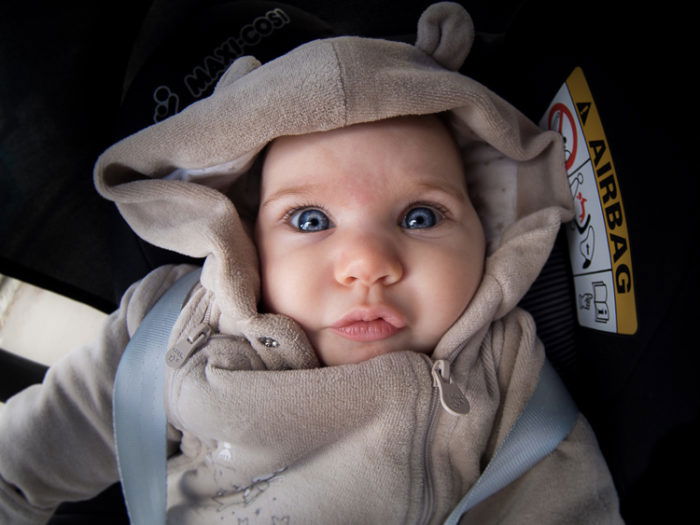
Natural Landscapes
Of all subjects, mayhap the 1 that suits a fisheye lens best is a natural mural. This is generally because landscapes have no straight lines in them. And if y'all place the horizon in the middle of the frame, it can go unnoticed that y'all take used a fisheye lens.
This is a groovy way to avoid ownership a broad-angle lens, particularly if you rarely shoot wide.
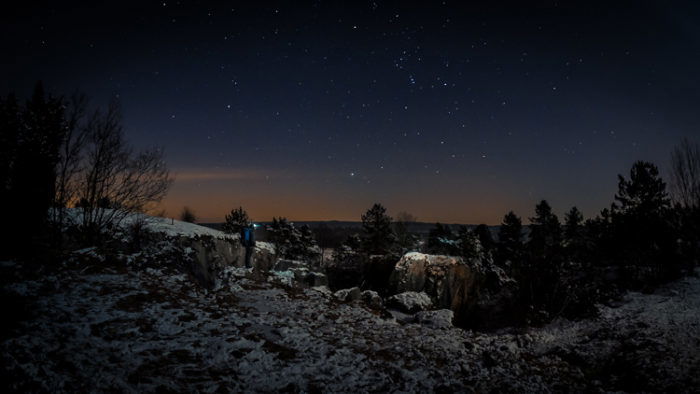
Fisheye lenses typically take a fast aperture, useful if you want to capture a big portion of the Milky Way while having a strong foreground with a large and interesting subject, like this small tree lost in tall grass shown in the photograph below.

Sometimes, it is nice to have a curved horizon in a landscape, in lodge to create stronger lines that will lead the viewer toward the field of study, as in this morning shot taken at the castle of Bornem, in Belgium.
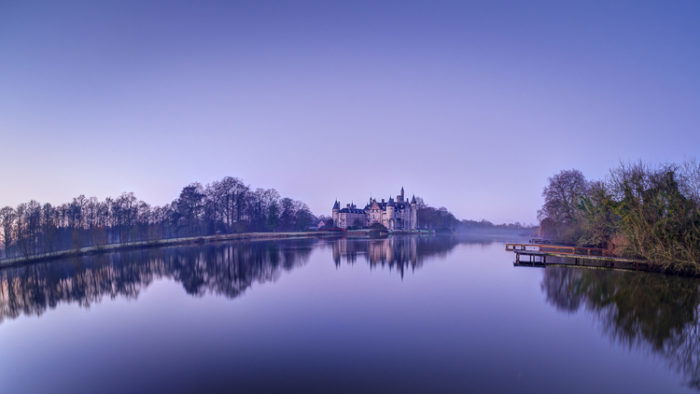
Fisheye and the City
Equally I said before, if you lot are a fan of urban environments, you lot should go a fisheye lens to capture monuments and tall buildings. For case, the Atomium is a world-famous monument in Brussels. It likewise happens to be 102m tall.
To capture it entirely at 24mm (equivalent to full-frame), you have to move dorsum about 80m from information technology. With my fisheye I was able to become it all into the frame from 15-20m away. The distortions helped create an original image of this famous location.
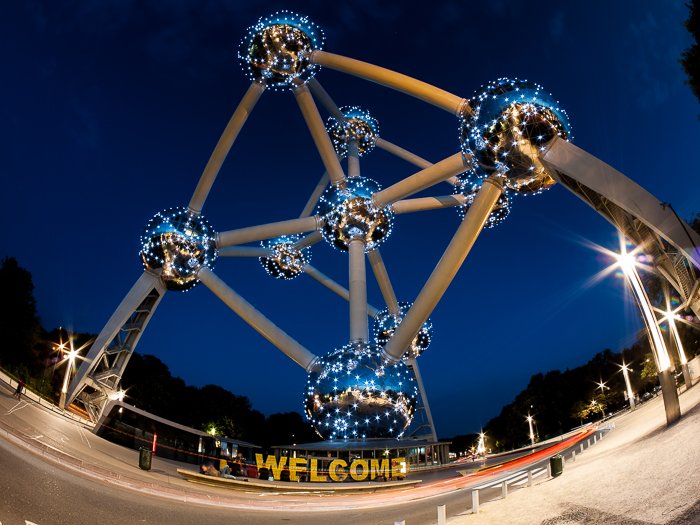
Another nice way to play with alpine buildings is to use the distortions to make them bend around the image as if they were huge waves virtually to break.
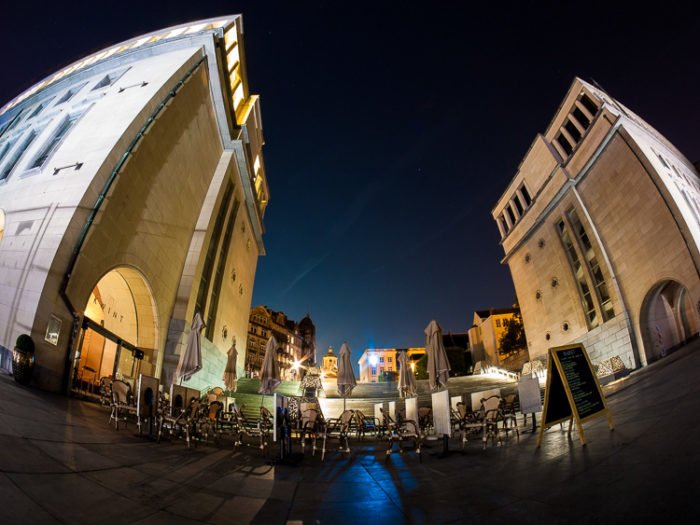
Yous should also take advantage of curved lines and amplify them to create stiff leading lines, similar this circular platform roof in front of Brussels Central Station.
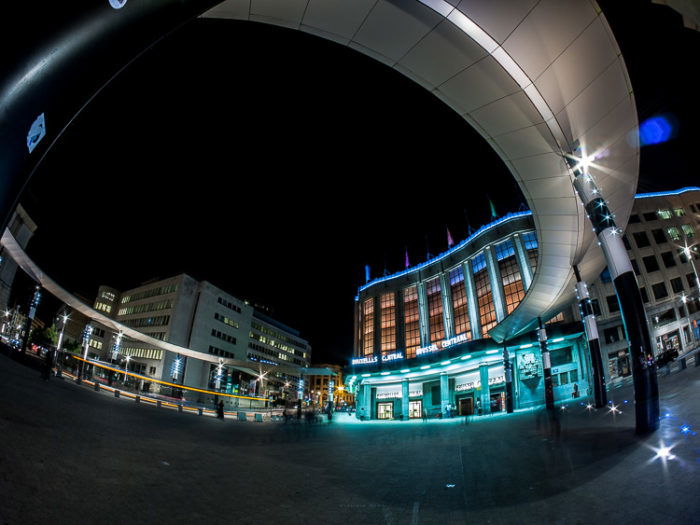
Finally, everybody shooting in the city has tried the classic photograph with night traffic lite trails. Unremarkably those trails are straight or snaking into the distance following the road.
With a fisheye you can get a full roundabout into the frame and accept some space left to get circular trails. This creates a nice 'traffic calorie-free carousel'.
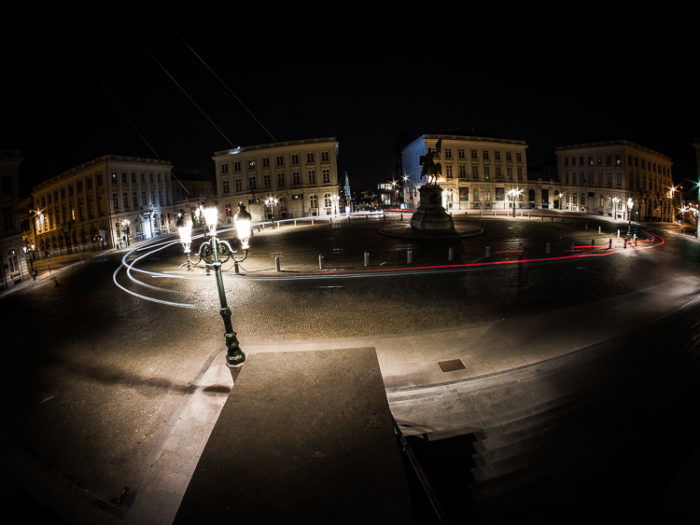
Earlier moving on to another subject, I would similar to indicate out that I didn't find lens flares to be an issue, every bit these nocturnal cityscapes (with their many street lights and other artificial lite sources) show.
Interiors
Yous tin can do indoor photography with a fisheye and easily get everything into a single image. I took this picture of a gallery in Brussels, which has some nice interior architecture.
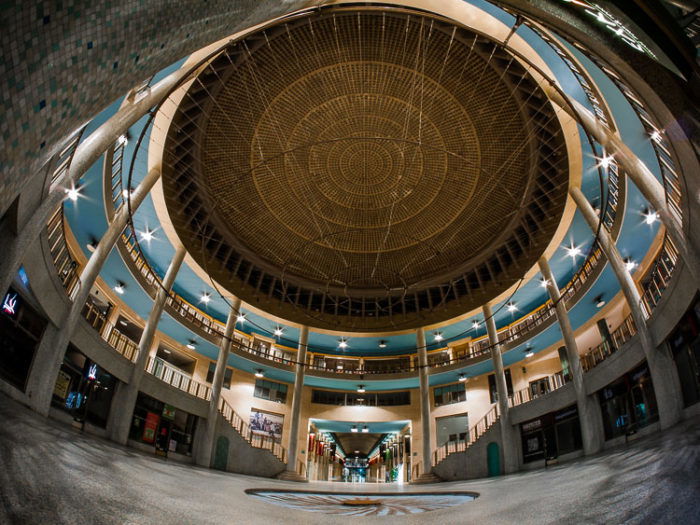
Bird'southward-Middle Perspectives
Information technology sounds funny to say, but you lot tin get some great bird'southward-eye views with a fisheye lens. If yous have access to a loftier vantage point, you can have a nice panoramic view over the city.
I'm lucky to live in a alpine building on top of a hill in Brussels. As such, I found myself climbing to the building roof quite frequently with my fisheye to take photos.
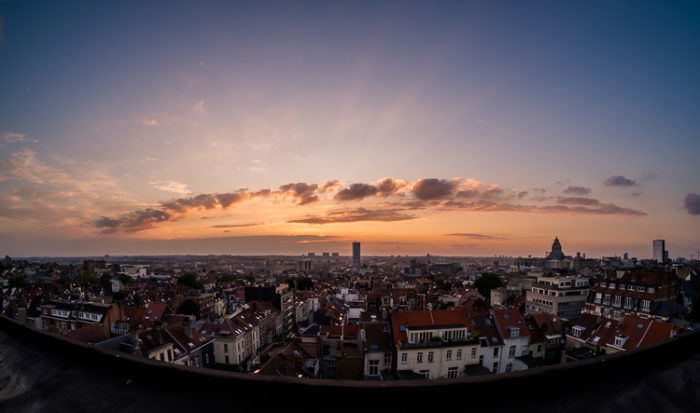
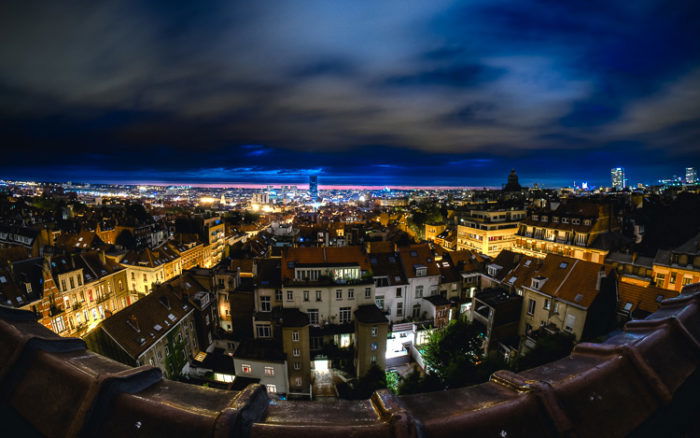
Need More Ideas?
Sports cars and motorbikes, as well as airplanes are great subjects for fisheye photography, provided that you can shoot from up close. People doing sports, similar skaters in a skate park, also make for interesting subjects.
The existent limit in using a fisheye lens, though, is your inventiveness and willingness to explore different possibilities.
Are you lot into street photography? With a bit of luck y'all can practise information technology even with a fisheye lens. I managed to become a lucky shot of a praying homo in the hall of the Justice Palace in Brussels at night.
The smashing merit of the fisheye lens in this photo lies in the way information technology highlights how huge the Justice Palace hall really is, compared with the praying human being in front of the big door. The lens's distortion brand it seem as though his surroundings are stretching to dominate the space above him.
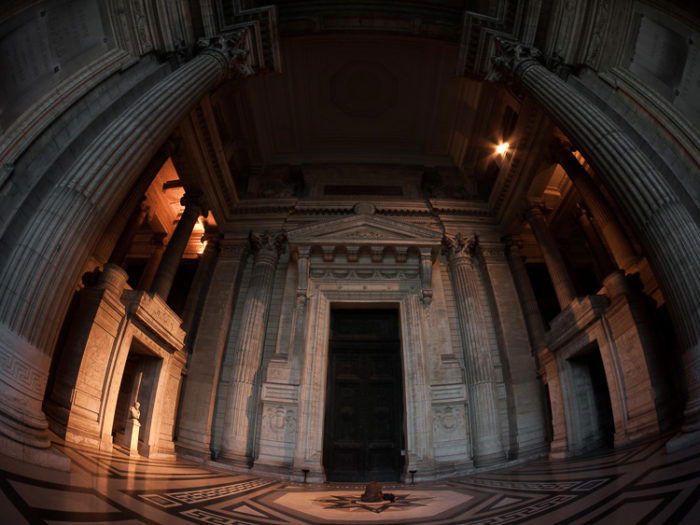
The Major Drawback in Fisheye Lens Photography: No Filters
Working with fisheye lenses is not great if you lot are addicted to photographic filters. As far as I know, no fisheye lenses tin can mount standard filters. This is due to the bulging forepart element of the lens. But y'all may notice some custom fabricated or DIY solutions.
Below, you can meet an example of why y'all may need to apply a filter with a fisheye lens.
I took this photo from the top of the Bayon waterfall in Belgium.
The use of a fisheye lens provides a nice, dynamic view of the area. I could combine many interesting elements, such as the water rushing down the waterfall, the colourful leaf, and the streaky clouds in the sky beyond.
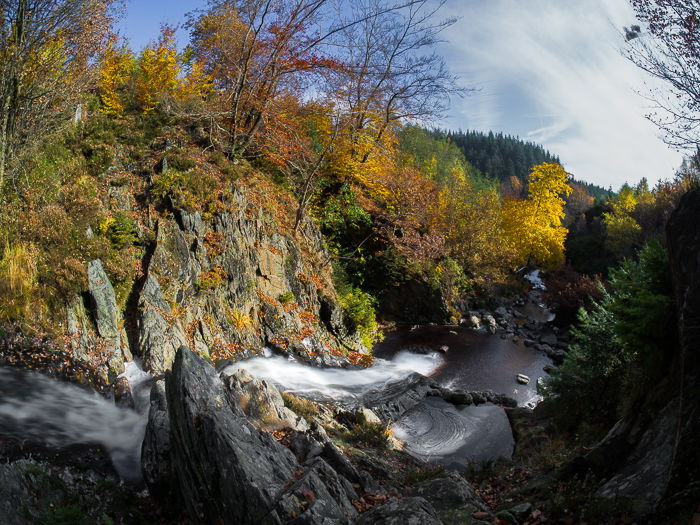
I wanted to take a scene that was dynamic, colourful, and large enough to capture the grandeur of the place. From where I was standing, I had to use my Samyang 7.5mm fisheye lens to do this.
I also wanted to incorporate the overnice, silky look of motion-blurred h2o over rocks, which meant I had to take a long exposure.
How to Deal with the Problem: Two Workarounds
Placing a handheld filter in forepart of the lens may piece of work with GND filters but for long exposures this is a 'no go'. Lite leakage will be unavoidable.
As mentioned earlier, considering these broad-bending lenses accept the front element bulging out, some, such as the Canon EF xi-24 f/4L USM, accept a rear slot for gelatin filters. Some people have taken to taping small pieces from ND gelatin filters to the rear chemical element of a fisheye lens.
The following video shows this DIY solution:
While this method is clever and cheap (gelatin filters are not expensive), you can only use ND (I think max three stops) and colour filters. Plus, due to their flimsy nature, they tear apart and become ruined easily.
Use the Epitome Averaging Technique
Some other solution is to apply theimage averaging technique. This consists of taking a large number of photos of the same scene and so averaging them in Photoshop.
The resulting image volition (i) benefit from having very low digital dissonance (see my introduction on the multi-frame dissonance reduction technique in this article) and (2) accept the moving subject blurred as if you took a long exposure.
The best results are accomplished by combining the use of the epitome averaging with the use of gelatin ND filters. As I had no gelatin filters at that time, I concluded up averaging eight single exposures, each 1/200s long.
When you do epitome averaging, your final exposure fourth dimension will exist the sum of the shutter speeds used for the single photos. In my example, the resulting total fourth dimension is (i/200) * 8 = 1/25. This does not really qualify as long exposure. The shutter speed is barely slow enough to blur the waterfall. It is, however, long enough to illustrate the concept.
Moreover, without gelatin filters to cut downwards the light, to get a total time of only v seconds, I should accept taken something like chiliad photos. That was not really feasible.
The concluding step in blurring the flowing water involves using Photoshop. After editing the photo in Lightroom, I re-imported it in Photoshop, duplicated the level and used a moderate motion blur filter (altitude=45) in the main direction of the waterfall.
I and then applied a mask to this layer to reveal everywhere, except for the waterfall, in the original image in the layer below it. The image beneath shows a 100% comparing of the water before and later on the utilise of the motion filter.
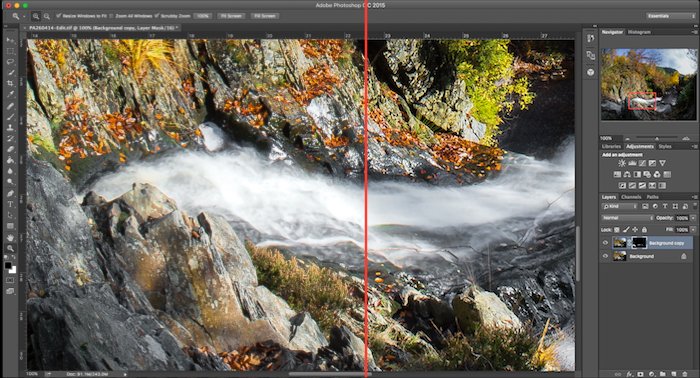
Determination
Now y'all are aware of how fisheye lenses work and when y'all can utilise them. Yous should be amend equipped to get the effects you want from this lens, whether yous're shooting a few fun novelty shots or doing more than serious photographic projects.
stoufferalwaskess.blogspot.com
Source: https://expertphotography.com/fantastic-fisheye-lens-photography-a-basic-guide/
0 Response to "Its Dark Fish Eye Lense Youre the Baby Quote"
Post a Comment